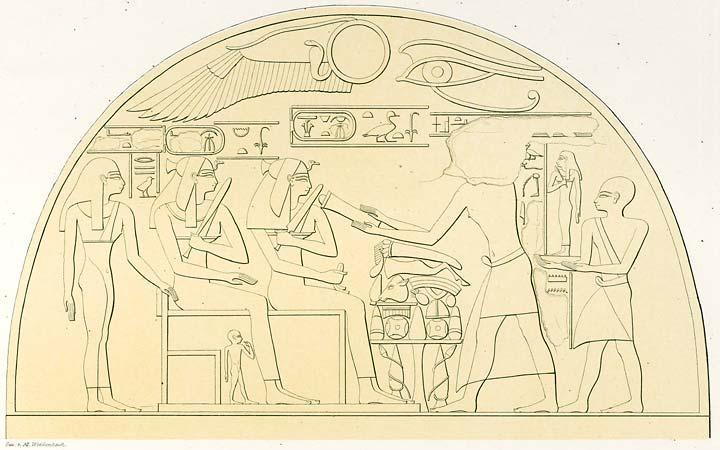Ahmose-Henuttamehu on:
[Wikipedia]
[Google]
[Amazon]
Ahmose-Henuttamehu (“Child of the Moon; Mistress of Lower Egypt”) was a princess and queen of the late 17th-early

 Not much is known about the life of Ahmose-Henuttamehu. The Queen is mentioned on a stela as depicted in Lepsius' Denkmahler.
Ahmose-Henuttamehu's mummy was discovered in 1881 in her own coffin in the tomb DB320 and is now in the
Not much is known about the life of Ahmose-Henuttamehu. The Queen is mentioned on a stela as depicted in Lepsius' Denkmahler.
Ahmose-Henuttamehu's mummy was discovered in 1881 in her own coffin in the tomb DB320 and is now in the
Mummy
{{DEFAULTSORT:Ahmose-Henuttamehu 16th-century BC Egyptian women Queens consort of the Eighteenth Dynasty of Egypt Ancient Egyptian mummies Wives of Ahmose I
18th
18 (eighteen) is the natural number following 17 and preceding 19.
In mathematics
* Eighteen is a composite number, its divisors being 1, 2, 3, 6 and 9. Three of these divisors (3, 6 and 9) add up to 18, hence 18 is a semiperfect numb ...
dynasties of Egypt.
Family
Ahmose-Henuttamehu was a daughter of PharaohSeqenenre Tao
Seqenenre Tao (also Seqenera Djehuty-aa or Sekenenra Taa, called 'the Brave') ruled over the last of the local kingdoms of the Theban region of Egypt in the Seventeenth Dynasty during the Second Intermediate Period. He probably was the son and ...
by his sister-wife Ahmose Inhapy
Ahmose-Inhapy or Ahmose-Inhapi (referred to as Anhapou by Maspero) was a princess and queen of the late 17th Dynasty and early 18th Dynasty.
Life
She was probably a daughter of Pharaoh Senakhtenre and was sister to Pharaoh Seqenenre Tao, and t ...
. She was probably married to her half-brother Pharaoh Ahmose I
Ahmose I ( egy, jꜥḥ ms(j .w), reconstructed /ʔaʕaħ'maːsjə/ ( MK), Egyptological pronunciation ''Ahmose'', sometimes written as ''Amosis'' or ''Aahmes'', meaning " Iah (the Moon) is born") was a pharaoh and founder of the Eighteent ...
, since her titles include King's Wife (''hmt-nisw''), Great King's Wife (''hmt-niswt-wrt''), King's Daughter (''s3t-niswt'') and King's Sister (''snt-niswt''). Ahmose-Henuttamehu was a half-sister to the Great Royal Wife
Great Royal Wife, or alternatively, Chief King's Wife ( Ancient Egyptian: ''ḥmt nswt wrt'', cop, Ⲟⲩⲏⲣ Ⲟⲩⲣϣ), is the title that was used to refer to the principal wife of the pharaoh of Ancient Egypt, who served many official ...
and God's Wife of Amun
God's Wife of Amun ( Egyptian: ''ḥm.t nṯr n ỉmn'') was the highest-ranking priestess of the Amun cult, an important religious institution in ancient Egypt. The cult was centered in Thebes in Upper Egypt during the Twenty-fifth and Twent ...
Ahmose-Nefertari
Ahmose-Nefertari (Ancient Egyptian: '' Jꜥḥ ms Nfr trj'') was the first Great Royal Wife of the 18th Dynasty of Ancient Egypt. She was a daughter of Seqenenre Tao and Ahhotep I, and royal sister and wife to Ahmose I. Her son Amenhotep I be ...
.
Life and burial

 Not much is known about the life of Ahmose-Henuttamehu. The Queen is mentioned on a stela as depicted in Lepsius' Denkmahler.
Ahmose-Henuttamehu's mummy was discovered in 1881 in her own coffin in the tomb DB320 and is now in the
Not much is known about the life of Ahmose-Henuttamehu. The Queen is mentioned on a stela as depicted in Lepsius' Denkmahler.
Ahmose-Henuttamehu's mummy was discovered in 1881 in her own coffin in the tomb DB320 and is now in the Egyptian Museum
The Museum of Egyptian Antiquities, known commonly as the Egyptian Museum or the Cairo Museum, in Cairo, Egypt, is home to an extensive collection of ancient Egyptian antiquities. It has 120,000 items, with a representative amount on display a ...
in Cairo
Cairo ( ; ar, القاهرة, al-Qāhirah, ) is the capital of Egypt and its largest city, home to 10 million people. It is also part of the largest urban agglomeration in Africa, the Arab world and the Middle East: The Greater Cairo metr ...
. It was examined by Gaston Maspero
Sir Gaston Camille Charles Maspero (23 June 1846 – 30 June 1916) was a French Egyptologist known for popularizing the term "Sea Peoples" in an 1881 paper.
Maspero's son, Henri Maspero, became a notable sinologist and scholar of East Asia ...
in December 1882. Henuttamehu was an old woman when she died, with worn teeth. Quotes from the ''Book of the Dead
The ''Book of the Dead'' ( egy, 𓂋𓏤𓈒𓈒𓈒𓏌𓏤𓉐𓂋𓏏𓂻𓅓𓉔𓂋𓅱𓇳𓏤, ''rw n(y)w prt m hrw(w)'') is an ancient Egyptian funerary text generally written on papyrus and used from the beginning of the New Kingdom ( ...
'' were written on her mummy bandages. She was probably buried together with her mother; her mummy was taken to DB320 along with other mummies after Year 11 of Pharaoh Shoshenq I
Hedjkheperre Setepenre Shoshenq I ( Egyptian ''ššnq''; reigned c. 943–922 BC)—also known as Shashank or Sheshonk or Sheshonq Ifor discussion of the spelling, see Shoshenq—was a pharaoh of ancient Egypt and the founder of the Twenty-sec ...
.
Ahmose-Henuttamehu is included in the list of royal ancestors worshipped in the Nineteenth Dynasty. She appears in the tomb of Khabekhnet in Thebes. In the top row, Prince Ahmose-Sipair
Ahmose-Sapair (also -Sipair) was a prince of the late Seventeenth Dynasty of Egypt (1580 to 1550 BCE).
Family
He was probably a son of Pharaoh Seqenenre Tao and a brother of Ahmose I, p.129 or the child of Ahmose I.Wente, Edward F. ''Thutmose II ...
appears on the left, and Ahmose-Henuttamehu appears as the fourth woman from the left, after the God's Wife and Lady of the Two Lands Ahmose, and the King's Wife Tures.Kitchen, K.A., Ramesside Inscriptions, Translated & Annotated, Translations, Volume III, Blackwell Publishers, 1996
References
External links
Mummy
{{DEFAULTSORT:Ahmose-Henuttamehu 16th-century BC Egyptian women Queens consort of the Eighteenth Dynasty of Egypt Ancient Egyptian mummies Wives of Ahmose I